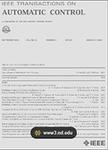版权所有:内蒙古大学图书馆 技术提供:维普资讯• 智图
内蒙古自治区呼和浩特市赛罕区大学西街235号 邮编: 010021

作者机构:University of Toulouse CNRS LAAS France Seoul National University ASRI Department of Electrical and Computer Engineering Korea Republic of University of California Department of Electrical and Computer Engineering Santa Barbara United States
出 版 物:《IEEE Transactions on Automatic Control》 (IEEE Trans Autom Control)
年 卷 期:2024年第70卷第7期
页 面:4344-4359页
核心收录:
学科分类:0711[理学-系统科学] 0808[工学-电气工程] 0809[工学-电子科学与技术(可授工学、理学学位)] 08[工学] 0701[理学-数学]
基 金:Project CyPhAI National Research Foundation of Korea AFOSR
主 题:Continuous time systems
摘 要:For a class of hybrid systems, where jumps occur frequently, we analyze the stability of system trajectories in view of singularly perturbed dynamics. The specific model we consider comprises an interconnection of two hybrid subsystems, a timer which triggers the jumps, and some discrete variables to determine the index of the jump maps. The flow equations of these variables are singularly perturbed differential equations and, in particular, a smaller value of the singular perturbation parameter leads to an increase in the frequency of the jump instants. For the limiting value of this parameter, we consider a decomposition which comprises a quasi-steady-state system modeled by a differential equation without any jumps and a boundary-layer system described by purely discrete dynamics. Under appropriate assumptions on the quasi-steady-state system and the boundary-layer system, we derive results showing practical stability of a compact attractor when the jumps occur sufficiently often. As an application of our results, we discuss the control design problem in a network of second-order continuous-time coupled oscillators, where each agent communicates the information about its position to some of its neighbors at discrete times. Using the results developed in this article, we show that if the union of the communication graphs being used for information exchange between agents is connected, then the oscillators achieve practical consensus. © 1963-2012 IEEE.